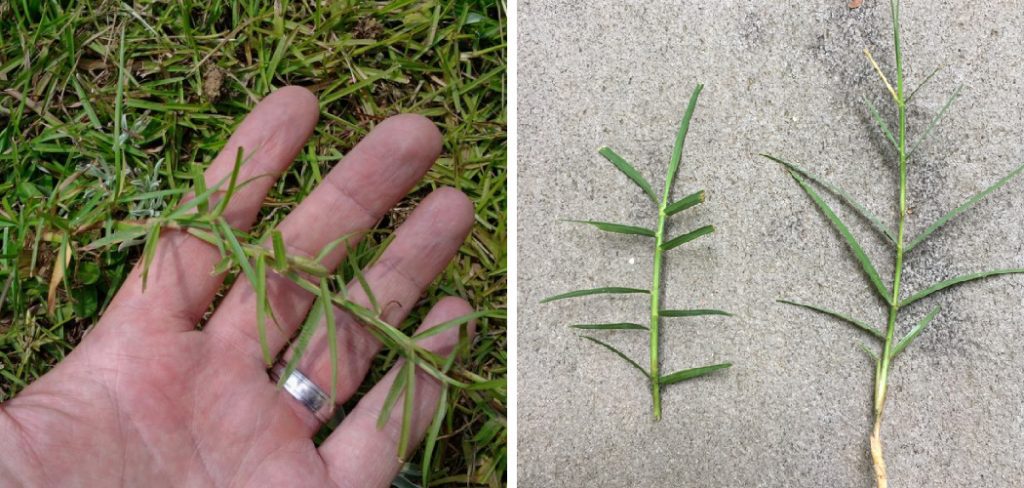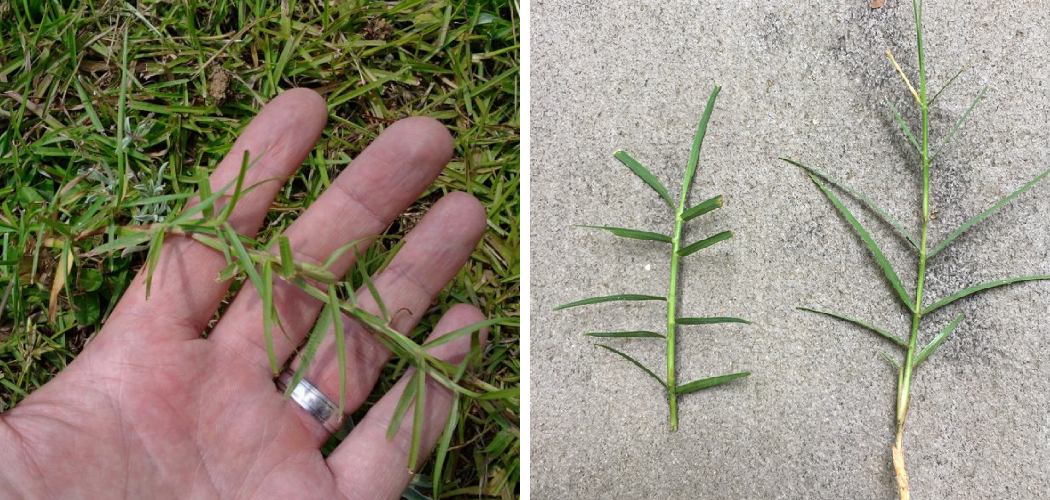Centipede grass can be identified by its coarse texture, light green color, and short upright stems. Centipede grass is easily recognizable due to its coarse texture, light green color, and short upright stems.
It is a low-growing, warm-season grass that thrives in southern lawns. Its leaves are long and narrow and feature a prominent midvein. Centipede grass is also known for its aggressive spreading habit through above-ground stolons. The grass requires minimal maintenance and is tolerant of drought and low fertility.
However, it can be susceptible to cold temperatures and heavy foot traffic. Overall, identifying centipede grass is straightforward, thanks to its unique characteristics.

How to Identify Centipede Grass: Step by Step Guide
Characteristics Of Centipede Grass
Centipede grass can be identified by its specific characteristics. Its color and texture are unique, usually light green with a coarse texture. The leaves are narrow and elongated, measuring around 1-2 inches in length. The overall growth pattern of centipede grass is low and spreading, forming a dense carpet-like appearance.
Its horizontal above-ground stems, known as stolons, help it spread quickly to fill in bare spots. Unlike other types of grass, centipede grass does not require much maintenance and is resistant to many pests and diseases. It thrives in warm climates and prefers acidic, sandy soil.
By recognizing these distinctive features, homeowners can easily identify centipede grass in their lawns or in the surrounding areas.
Identifying Centipede Grass By Appearance
Centipede grass can be identified by its appearance, particularly through the presence of stolons and rhizomes. These above-ground and below-ground runners help the grass spread horizontally across the lawn. When it comes to blade shape and edges, centipede grass has narrow leaves with rounded tips and a sharp edge.
Its typical growth pattern forms dense, low-maintenance turf. Moreover, seedhead characteristics provide another clue for identification. Centipede grass produces seedheads that consist of multiple spikes attached to a single stem. It’s important to be aware of these distinguishing features in order to accurately identify centipede grass in your lawn.
By observing the presence of stolons and rhizomes, blade shape and edges, and seedhead characteristics, you can easily differentiate centipede grass from other grass types.
Differentiating Centipede Grass From Similar Grass Types
Centipede grass can be easily identified by observing its characteristics compared to other similar grass types. When comparing centipede grass to bermuda grass, you’ll notice that centipede grass has wider and coarser blades. Unlike st. augustine grass, which has more broad and flat blades, centipede grass has narrow, pointed leaves.
Another distinguishing factor is the difference between centipede grass and zoysia grass. Zoysia grass has a denser growth pattern and has finer blades compared to the coarser texture of centipede grass. Although these grasses may appear similar at first glance, paying attention to their blade width, leaf shape, and growth habit can help you accurately identify centipede grass in your lawn.
Remember to consider these key characteristics to differentiate centipede grass from other grass types.
Practical Tips For Identifying Centipede Grass
Centipede grass can be easily identified by observing its leaf sheaths, stolon nodes, and root structure. Leaf sheaths of centipede grass can be short and smooth, with a reddish-brown color. By examining the stolon nodes, you can detect the presence of small, purple-colored hairs.
The root structure of centipede grass is shallow and fibrous, which enables it to spread horizontally. Additionally, you may notice that the grass grows in a dense and low-maintenance turf. These practical tips will help you accurately identify centipede grass in your lawn or garden.
By being observant and analyzing these key characteristics, you can confidently recognize and differentiate it from other grass types. Remember to pay attention to leaf sheaths, stolon nodes, and root structure for accurate identification.
Seasonal Changes And Centipede Grass Identification
Centipede grass identification can be easily done by observing its seasonal changes. During winter, the grass goes into a dormant phase, turning brownish-yellow in color. In summer, centipede grass can experience stress due to prolonged heat and drought, exhibiting signs like wilting and discoloration.
However, it is in spring and fall that centipede grass reveals its distinct characteristics. In spring, this grass starts to green up and enters an active growth phase, while in fall, it takes on a beautiful bronze hue. By understanding these seasonal variations, you can effectively identify centipede grass and ensure proper care and maintenance throughout the year.
Keeping an eye on these changes will help you keep your centipede grass lawn thriving and healthy.
Tools And Techniques For Accurate Identification
Identifying centipede grass requires the right tools and techniques for accurate results. One approach is to opt for professional lawn analysis which involves expert evaluation. Alternatively, you can utilize diy lawn testing kits to gather essential information about your grass type.
Consulting with local experts can also provide valuable insights and guidance in identifying centipede grass. These professionals have extensive knowledge of the grass varieties prevalent in your area and can offer personalized solutions. Utilizing their expertise and tools, you can determine whether or not your lawn consists of centipede grass, ensuring proper care and maintenance for a beautiful and healthy yard.
Common Mistakes When Identifying Centipede Grass
Common mistakes when identifying centipede grass include confusing it with other weeds and misidentifying grass varieties. These errors often arise due to a lack of expertise in grass identification. To avoid making these mistakes, it’s important to carefully examine the characteristics of centipede grass and compare them with other commonly mistaken weeds.
Pay attention to details such as leaf texture, color, and growth pattern. Seek guidance from experts or reputable resources to enhance your knowledge and sharpen your identification skills. By being meticulous and thorough in your assessment, you can confidently identify centipede grass and differentiate it from other similar-looking plants.
Benefits Of Properly Identifying Centipede Grass
Proper identification of centipede grass is crucial for maintaining a healthy and vibrant lawn. By correctly identifying this type of grass, you can take advantage of its numerous benefits. One of the primary advantages is the ability to implement effective lawn maintenance strategies.
Appropriate fertilization and weed control are essential for ensuring optimal growth and minimizing unwanted plant species. Additionally, identifying centipede grass helps in devising strategies to minimize pest infestations that can damage your lawn. By understanding the unique characteristics of centipede grass, you can tailor your lawn maintenance routine to suit its specific needs.
Employing these strategies will result in a lush, green centipede grass lawn that enhances the overall appeal of your property.
Frequently Asked Questions On How To Identify Centipede Grass
How Can You Tell The Difference Between A St Augustine And A Centipede?
St. augustine and centipede grasses have distinct characteristics to differentiate them. Their appearances, growth habits, and maintenance requirements can help you tell them apart. St. augustine grass has wide, flat blades and a dense growth pattern. It thrives in warm climates and tolerates shade well.
On the other hand, centipede grass has narrow, pointed blades and a more open growth habit. It prefers full sun and has lower maintenance needs than st. augustine. To identify them further, you can also look for differences in color and texture.
St. augustine grass has a lush, blue-green color with a coarse texture, while centipede grass has a lighter green color with a finer texture. By observing these characteristics, you can easily distinguish between st. augustine and centipede grasses in your lawn or garden.
How Do I Know If I Have Bermuda Or Centipede Grass?
To determine whether you have bermuda or centipede grass, you can follow these simple steps: 1. Analyze the leaf blades: bermuda grass has fine-textured, wiry leaf blades, while centipede grass has wider, coarser blades with notched tips. 2. Examine the density: bermuda grass forms dense turf due to its rapid spreading nature, whereas centipede grass grows in a more open and sparse manner.
3. Check the color: bermuda grass exhibits a vibrant green hue, while centipede grass features a lighter green or yellowish-green color. 4. Observe the growth habit: bermuda grass grows aggressively and can infiltrate flower beds and other areas, whereas centipede grass has a slower growth rate and is less invasive.
By carefully assessing these characteristics, you can identify whether your lawn consists of bermuda or centipede grass. Remember to consider the leaf blades, density, color, and growth habit to make an accurate determination.
What Does A Blade Of Centipede Grass Look Like?
Centipede grass blades are slender, delicate, and have a unique canoe shape. Each blade is roughly 1 to 3 inches long, with a tapered tip and distinct parallel veins. The leaves are a light green color, resembling a lush carpet when grown densely.
This warm-season turfgrass is known for its low-maintenance qualities and ability to tolerate a wide range of soil conditions. Its blades have a fine texture and grow laterally, creating a dense cover. Despite being relatively low-growing, centipede grass can still provide a lush and attractive appearance to lawns and landscaping.
Its distinct blade shape and light green color make it easily distinguishable from other grass varieties, adding to its aesthetic appeal.
What Does Centipede Grass Thatch Look Like?
Centipede grass thatch appears as a thick layer of intertwined stems, roots, and debris on the lawn surface. It can look like a brown or tan mat, similar to a dense carpet. Thatch is commonly found in centipede grass lawns due to its spreading growth habit and the accumulation of dead plant material over time.
Properly maintaining the lawn by regular mowing and aeration can help prevent excessive thatch buildup.
Conclusion
Identifying centipede grass can be a challenge, but armed with the right knowledge, you can spot it with ease. By understanding the distinct characteristics of centipede grass, such as its coarse texture and pale green color, you can differentiate it from other grass varieties.
Additionally, observing its growth pattern, which includes producing dense mats and shallow root systems, can help confirm its identification. It’s important to note that centipede grass thrives in warm, humid climates and requires minimal maintenance. Therefore, if you live in a region with these conditions and notice these specific features in your lawn, chances are you have centipede grass.
Remember, proper identification is crucial for effective lawn care. By correctly identifying centipede grass, you can ensure that you provide it with the specific care it needs to flourish. So, take the time to familiarize yourself with its characteristics and enjoy a vibrant and healthy lawn.

